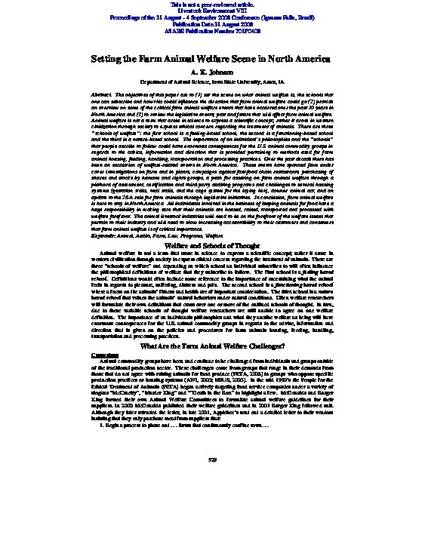
The objectives of this paper are to (1) set the scene on what animal welfare is, the schools that one can subscribe and how this could influence the direction that farm animal welfare could go (2) provide an overview on some of the critical farm animal welfare events that have occurred over the past 10 years in North America and (3) to review the legislative events; past and future that will affect farm animal welfare. Animal welfare is not a term that arose in science to express a scientific concept; rather it arose in western civilization through society to express ethical concern regarding the treatment of animals. There are three “schools of welfare”: the first school is a feeling-based school, the second is a functioning-based school and the third is a nature-based school. The importance of an individual’s philosophies and the “schools” that people ascribe to follow could have enormous consequences for the U.S. animal commodity groups in regards to the advice, information and direction that is provided pertaining to methods used for farm animal housing, feeding, handling, transportation and processing practices. Over the past decade there has been an escalation of welfare-related events in North America. These events have spanned from under cover investigations on farm and in plants, campaigns against fast-food chain restaurants, purchasing of shares and stocks by humane and rights groups, a push for assuring on farm animal welfare through a plethora of assessment, certification and third-party auditing programs and challenges to several housing systems (gestation stalls, veal stalls, and the cage system for the laying hen), downer animal act, and an update to the 28-h rule for farm animals through legislative initiatives. In conclusion, farm animal welfare is here to stay in North America. All individuals involved in the business of keeping animals for food have a huge responsibility in making sure that their animals are housed, raised, transported and processed with welfare forefront. The animal livestock industries will need to be on the forefront of the welfare issues that pertain to their industry and will need to show increasing accountability to their customers and consumers that farm animal welfare is of critical importance.
Available at: http://works.bepress.com/anna_butters-johnson/320/

This proceeding was published as Johnson, Anna Kerr. "Setting the farm animal welfare scene in North America." In Livestock Environment VIII, 31 August–4 September 2008, Iguassu Falls, Brazil. 2008. American Society of Agricultural and Biological Engineers.